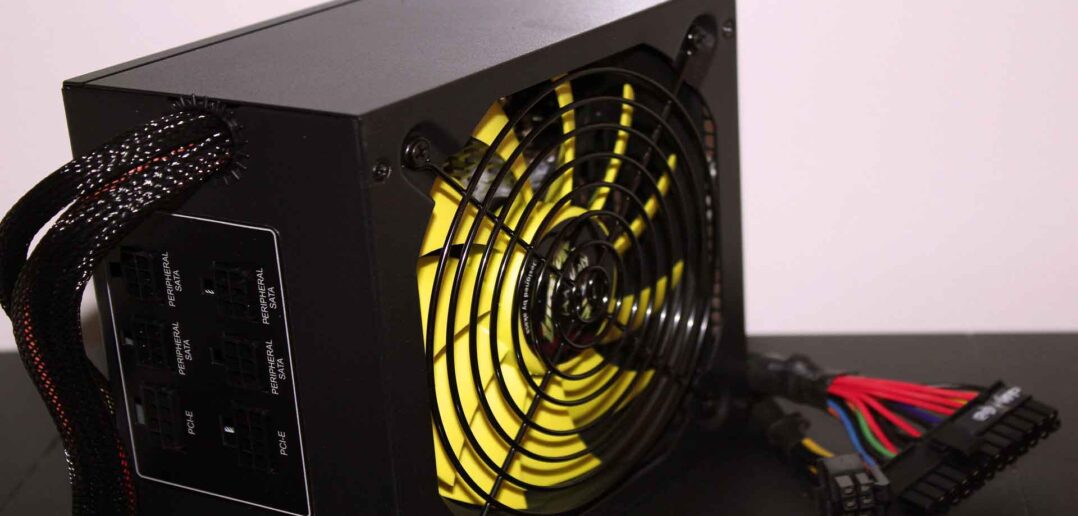A computer’s Power Supply, or PSU, is one of the most critical parts of your computer. Poor quality power supplies can cause issues with system stability and have a higher risk of failure. High-end gaming PC’s and workstations in particular have a much higher power draw, requiring a power supply that can deliver that power. This makes it critical to choose wisely to avoid these issues.
If you are buying a pre-built computer, this is an area that you don’t normally need to worry about. The power supplies in these machines tend to be already well matched to the machine’s intended use. However if you’re building your own machine, you will need to find something that matches how you use your computer.
This guide should point you in the right direction towards picking an appropriate power supply and make sure you buy something that delivers enough power to keep your machine stable.
Low-End Office Machines
For lower end machines, the power supply requirements are fairly modest. The reason for this is that these machines tend not to have high-powered graphics cards in them, and may even be using onboard graphics. The big power consumer here tends to be the CPU.
As a general guide, lower-end Intel CPU’s such as the Intel I3, use a maximum of 65 watts of power. The lower-end AMD Ryzen CPU’s such as the Ryzen 3 3200G, also use a maximum of 65 watts of power.
The rest of the machine also needs to be accounted for. These tend to account for very little when you add them up. Allocating 40 watts for the motherboard would be particularly generous. A DVD drive can use up to around 30 watts. Hard drives typically use less than 10 watts each. RAM would use around 3 watts a stick, and the same can be said for fans. The TL;DR version of working this out is you could probably use a nice round 100 watts for the rest of the system and get away with it. This should get you a maximum power draw of approximately 165 watts if you use onboard graphics.
What this means that for a typical office-style workstation, you could get away with a power supply of around 350-400 watts. This would be a good absolute minimum to aim for in this scenario.
There is of course no harm in going higher than this . A common misconception is that using a higher wattage power supply means you use more power. This isn’t quite true. The power supply will only push out as much power as the components need, up to a maximum of what they are rated at. This means you could use a 500 watt power supply and it would not make any meaningful difference to your power usage. We would probably recommend doing this from the start, as it gives you more room to add a modest graphics card and a more powerful processor should the need arise.
High-End Gaming PCs and Workstations
If you’re using a machine for gaming or for other tasks that require a high-end workstation, the above recommendations might not be enough. The reason for this is that the processors used for this tend to use quite a lot more power, and the graphics cards used for these tasks can also use a significant amount of power.
As a guide, the Intel I9 CPU’s can use up to 125 watts of power, nearly double that of the lower-end I3’s. The AMD Threadripper can use up to an eye-watering 280 watts of power.
For graphics, a NVIDIA RTX 3090 can use up to 360 watts of power, while an AMD 6900XT can use up to 300 watts. When you combine these high-end CPU’s with high-end graphics cards, it can start adding up very quickly.
If you’re using parts at this level, I would suggest an 850 watt minimum for an Intel machine, with an AMD Threadripper potentially requiring at least 1000 watts. You may be able to go down to a 750 watt power supply in some configurations, but that might be cutting it a bit fine if you’re known to push your computer to the limit.
There is one other thing to pay particular attention to here when buying a power supply. The 12 volt line is the one that powers the graphics cards in these scenarios. While most decent power supplies have adapted to accommodate these high-end video cards, it is still worth taking this into account if you’re considering these cards. The general rule is, all things, being equal, a higher ampage on the 12 volt line will handle the load of these cards better. If you have a number of different options you’re considering, this might help narrow this down a bit further for you.
What about these 80% efficiency ratings?
You may have seen various power supplies being certified has being 80% efficient. There are various levels of this rating, with the higher ratings of course being held to a higher standard.
You may be wondering why this is important. It’s a complex topic to discuss, and to describe it in thorough detail would involve more than a few paragraphs in an article. The main things to take away from these certifications is that they would denote not just a potential saving on your power bill. They also indicate that the power supply is made of better quality components and of a better build quality than your typical bargain-basement power supply.
Whether you can justify the extra money for a Titanium certification over a Bronze certification is entirely up to you, it is worth going for a power supply that has one of these certifications. The power savings might only be trivial depending on how much you use your machine. The better components and build quality of these power supplies would be worth the expense because they are less likely to randomly fail and more likely to last well beyond the life of your computer. This is worth the extra couple of dollars they add to the cost of your machine.
Verdict
We’ve essentially covered two different extremes here that represent two different ends of the market, both the low-end and the high-end. While this might seem fairly simplistic, these two extremes represent the vast majority of circumstances you might find yourself in.
The important thing to work out is which camp you fall into so you can work out what sort of target wattage to aim for, and then look for a power supply with at least that wattage that has some form of 80% efficiency certification that fits your budget. The other thing to take away from this is that if you’re wanting the machine to last a while, you should probably avoid going for the bargain-basement power supplies.
We hope this helps you narrow down your choices to something that would be suitable for your needs and navigate the plethora of power supplies available and guide you towards one that makes sense for your use case.



